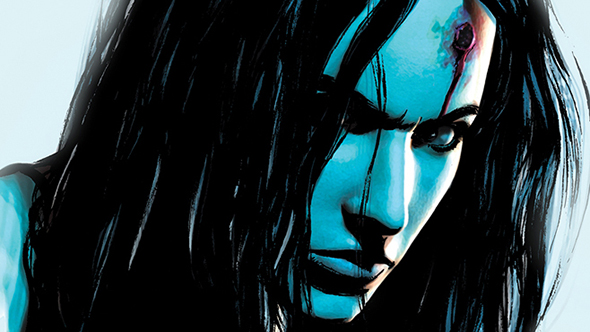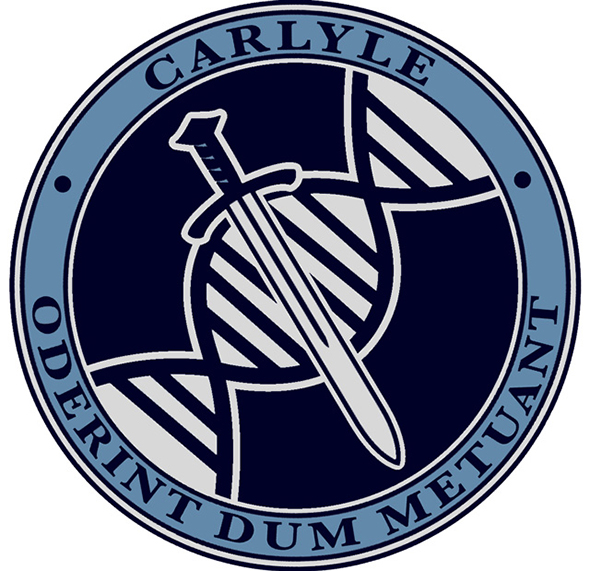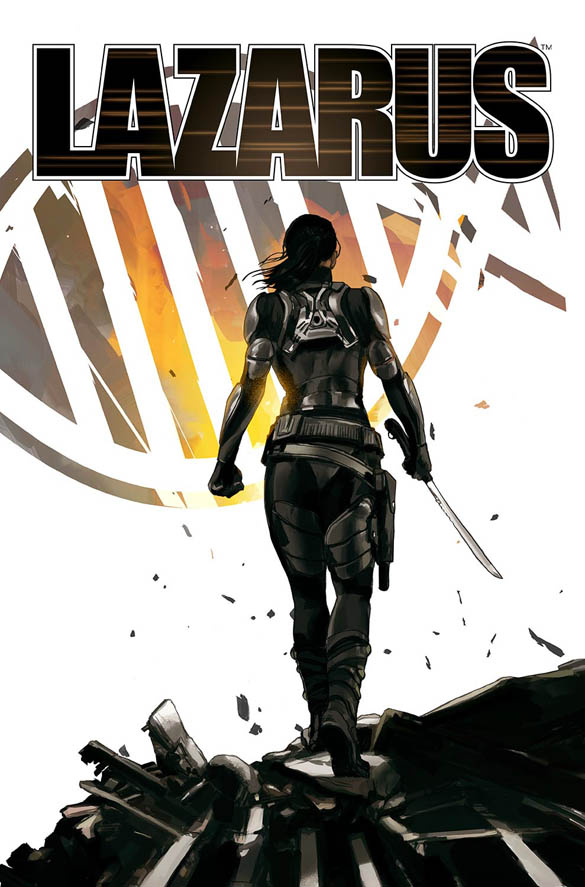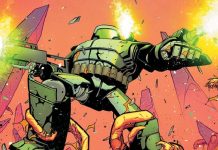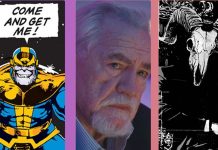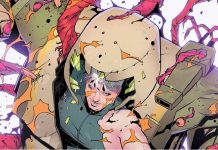Rucka and Lark have been one of my favorite pairings ever since the Half a Life arc in Gotham Central, and their work has only gotten stronger and more cohesive since that was first published. They’re now deep into their most ambitious collaboration to date, the Image Comics series Lazarus. With the freedom of creator-owned they get to pour their hearts and souls into the work in ways that weren’t possible at the Big Two, and it shows. I talked to the duo about how they work together, covering their process, decision-making and the pains and joys that come with such a tight-knit bond.
How much do you two discuss the overarching story of Lazarus?
Greg Rucka: Michael gets a sort of grand view, but things are always changing as I work on it. I know where we’re going. I have an ending in mind; I’ve always had the ending in mind. But the route to get there evolves and sort of needs to evolve, depending on the work that we’ve done and how it’s progressing. We tend to discuss specific arcs more [than the overall story]. Michael gets a script, and he’s a very close reader. He’s not just looking at what he needs to draw; he reads very closely and comes back with questions about characters and the overall direction. He constantly challenges me, keeping me very honest.
Michael Lark: Sometimes to his chagrin!
GR: [Laughs] Sometimes. At times Michael will knuckle down on things and I just need to say, “Trust me on this, you’re wrong.” And then he points out something that shows he’s 100% right. I think in that sense we have an ideal collaboration. I don’t want to work with anybody that doesn’t care. [Lazarus] is ours together and it’s not a collaboration if Michael isn’t free to voice his thoughts. I would like to think that as frustrating as it can be, and it can be frustrating as Michael described, the end result shows the work put in and I wouldn’t change it.
ML: If we weren’t challenging each other what would be the point in doing it, really? We both have the end goal in mind of making it the best possible book we can so it’s not like it’s ever, “Greg’s an idiot, he’s wrong” or, “Michael doesn’t know what he’s talking about.” It’s always about what’s going to serve the story and the readers. There are times where it boils down to gut instinct. There’s an ongoing discussing we’re having about something in the current issue we’re working on. My gut is telling me one thing and Greg’s is saying something else, so we have to walk the line between them. It’s not even that important, but we still have those discussions.
GR: It’s interesting because it kind of is an important issue because it’s less a story issue than a question about what we want the book to be and what we want to be saying in it. And those are sometimes the most important aspects rather than what’s the coolest twist or how do we make a scene look amazing. Another joy of working with Michael is that we find ourselves wrestling with deeper questions, and questions that readers would never even consider. But we know that we’re having these discussions. [Laughs] So it’s hard to answer in the specific on that; we’re talking around this thing that Michael and I are wrestling with. And we’ve been exchanging emails over the last 24 hours. It’s an artistic choice for a sequence; that’s what it comes down to. And in that decision Michael has to decide how to compose those panels. And the information that needs to be in those panels has to be information that CAN fit into those panels. And in the CAN part we’re really talking about something that affects the book on some level. There are arguments for each option, but at the end of the day I’m going to defer to him because he knows how to tell the story visually. That’s the thing he’s spent his life learning; that’s his skill set. So for me to get in the way of that in any fashion is absurd.
How has the amount of work required under the Image model compared with your expectations?
ML: It’s like working on an indy book. That’s how I started out, on self-published books. There are some things we don’t have to do like printing and distribution, but with something like marketing there’s a lot more work. At Marvel or DC you draw the page, send it in and you’re done. There’s this whole big machine that takes over and the gears grind and the comic is spit out at the end of it. We definitely get a lot more involved in the marketing and promoting of the book. There are a lot of decisions that I took for granting that are being made by the brain trusts at the Big Two that we have to make now. And that’s good; I’m not complaining about it, I actually prefer it. And in a lot of ways I think we’re more qualified to make the decisions than those people were.
What features are in the Second Collection?
GR: We’ve got a really cool breakdown of the fight at the end of Conclave [the fourth arc], which was a big moment for us just in terms of how we collaborate. It’s something we talked about doing almost immediately after that issue came out and we’re happy to be able to show the process. We’ve got an update of the World Map, so you’ll see how the socio-political situation has changed from the end of the first two arcs to now. We’ve got a Eric Trautmann [the designer of Lazarus] tour de force of close ups and unused bits of Hock propaganda, posters and advertisements. Eric adds a lot of things which might not be seen in the comics but are a ton of fun. I believe Owen Freeman is doing another cover. We’ve got at least one piece of art that had to be revised for an issue, so we’re going to run the original piece in the collection. There’s more than enough good stuff in there.
ML: There’s actually going to be a lot more than there was in the first volume just because of the way the number of pages in the issues versus the page count requirements for the hardbacks. We ended up with a lot of extra pages this time which means a lot of material for people who buy it.
GR: I think something we’ve tried to do is deliver as much as we can. We try to never waste a page; they’re all precious. This is a HUGE hardcover. It’s chocked to the brim with tasty chewy bits.
Greg, have you been structuring Lazarus so that every two arcs collected in the hardcovers feel like its own piece of the larger story? Do you consider the hardcovers when pacing it?
GR: No, not really. I think of the story in terms of arc so that each individual arc moves the overall story a specific distance towards our end goal. We plan to keep doing the hardcovers every two arcs because they make nice editions, and I think Michael and I are partial to having a hardcover version of our work that’s an easy collection of it and has a lot of additional content. Currently we’re working on Cull, the fifth arc, and I’m not thinking about our third hardcover at all. I’m thinking about what I have to do in issues 23, 24, 25 and 26. How do I do this thing I wanted to do in Issue 22 that Michael talked me out of [laughs] How we fit it in later, things like that. Those are the the concerns.
Michael, most of your time is devoted to Lazarus.
I don’t have any time to work on anything else. I’m barely able to get Lazarus done, as our schedule has shown. It’s a lot of work, more than any other comic I’ve ever done. There’s so much background material that has to be designed and thought out. How did you put it Greg?
GR: You’re a close reader.
ML: Yeah. I have to drill really deep into the script. In a scene where Forever is wheeled into an emergency room, I have to consider what an emergency room in this world looks like in whatever year we’re in. That’s not something I can just get a picture of off the internet. How many questions have I sent you about things like where the IV bags should be. There are so many little details that I have to ask about. At first I was taking a little more of a cavalier approach to that and I kind of had my wrist slapped a bit for using the wrong guns and things like that. There’s a lot of research and a lot of background that goes in before I start drawing the page.
What makes the two of you such a strong team and brings you guys back together, over and over?
GR: I think one of the reasons that we work really well together is we like each other and that has resulted in a friendship that I think each of us has a great deal of faith in and that has lasted a very long time. It’s a testament to the friendship that we can argue and fight about things on Lazarus and remain friends, and that we can turn to each other for problems going on in our lives. Michael and I are very different people, but we have many many places of intersection, and many many of our interests are similar, especially artistically. We’re very tightly aligned.
ML: I also think our differences compliment one another.
GR: Absolutely.
ML: Greg is more serious and gets very passionate about the serious aspects of this story, and I find myself excited about people with swords jumping around and punching each other. We balance each other out that way and I think that if one of us were to have more control over the final product than the other one than it wouldn’t be as good.
GR: It would certainly hurt [the final product]. We’re partners in this; this isn’t one of us in front of each other. Michael and I have stood shoulder to shoulder on Lazarus since the word go. That’s where we’re gonna be when it ends.
ML: We always have the same goal in mind, which is to do the best comic we can do. And we may go into it with different expectations in how that’s going to work and then we have to marry those expectations and find common ground. We’re making it sound like there’s a lot more conflict than there is. When conflict does arise we find a solution that is different from either of our expectations and that’s the way collaboration is supposed to work. That’s the joy of doing something like this. I’ve worked with writers who even tell me what the page layout should be and I’m told not to change that. Well, why the hell are you even hiring me then? Draw your own damn selves. Greg knows that I’m going to bring my best to this thing and he doesn’t need to tell me what to do. He lets me do my thing and I let him do his thing and hopefully somewhere in the middle we make good comics.
GR: Our comics feel like more than a sum of their parts. I think that starts with our relationship and extends to Jodie and Santi and Tyler and Eric. Everybody who comes aboard is additive.
ML: A big dysfunctional family. [Laughs]
GR: Happily dysfunctional, I think.
Lazarus: The Second Collection, along with the first hardcover volume, are now on sale digitally, online and in your local comic book store. Follow Greg on Twitter @ruckawriter and Michael @michaellark66.


